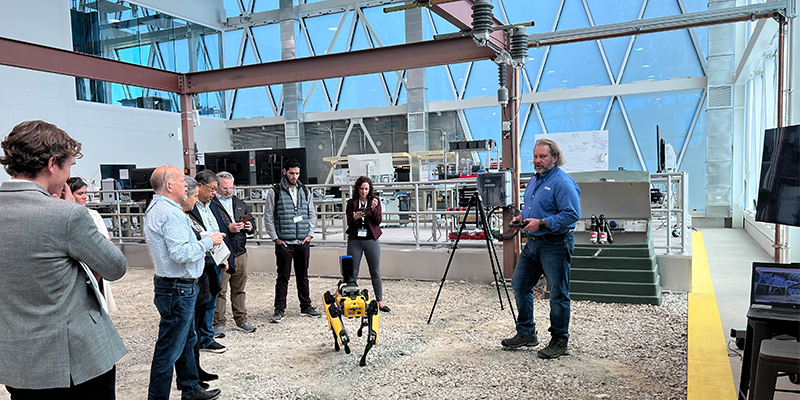Technology continues to drive rapid change across project and asset lifecycles. On a tour of the Oracle Industries Innovation Lab in Deerfield, Illinois, as part of CRE.Converge 2022, attendees were able to explore some of the latest advances in autonomous equipment, augmented reality, artificial intelligence, machine learning, drones and other developing technologies.
Oracle calls the lab – complete with a simulated worksite lined with chalky gravel – “a unique idea incubator designed to help businesses in a variety of industries tackle their most complex challenges.”
The Chicago innovation lab completed construction in November 2020, and Oracle launched innovation labs in Reading, U.K., and Sydney, Australia, this past summer.
Shirley Chen, with Oracle’s Construction & Engineering Global Business Unit, shared some staggering statistics at the start of the tour:
- The global construction market is estimated to reach $17.5 trillion by 2030.
- In the past 10 years, the share of megaprojects ($1 billion in in value or greater) has grown from 4% to 42% of all construction spending.
- $4.34 billion has been invested in construction technology startups in the last 10 years.
- 76% of engineering and construction executives plan to invest in at least one technology in 2022.
Oracle has a special program (which Chen jokingly called “Shark Tank Oracle”) which allows the company to evaluate and partner with startups that are developing new, cutting-edge technologies, similar to a venture capitalist. These partnerships allow the startups the visibility they’re looking for and provide Oracle another source of valuable data points that can be included and layered upon within their common data environment.
While in the lab, tour attendees had the opportunity to learn about – and in many cases, touch and try:
- The Milwaukee Tools One-Key system, which utilizes sensors to track the location of (often expensive) tools and equipment on a construction site.
- An ultralight HILTI “exoskeleton” that allows workers on a construction site to safely raise heavy items such as wall panels and relieve strain on shoulders and arms during overhead installation work.
- The FARO Trek LiDAR (light detection and ranging) scanner, which takes 300-degree 3D views of a project site resulting in measurements accurate within 2 mm.
- Boston Dynamics’ Spot mobile robot, the viral “robot dog” which allows for technologies like the FARO Trek scanner to be used in locations that might be inaccessible or unsafe for workers.
- A “smart condo” area with integrated smart appliances that can adapt to maximize energy efficiency. For example, AI analysis of energy usage might mean running a load of laundry or a dishwashing cycle during non-peak energy-using hours.
- Magic Leap X Geopogo augmented reality glasses, which allowed attendees to walk through a real-time architectural visualization of a medical office space.
FARO technologies’ Kipp Ivey shared an anecdote that further brought some of the technology to life: Years ago, FARO used one of their LiDAR scanners to create a full 3D map of the Notre Dame Cathedral in Paris. A video game developer wanted to use in the design for a game, Assassin’s Creed. Years later in 2019, when the Notre Dame Cathedral caught fire and sustained major structural damage, FARO donated the legacy 3D data of the cathedral so it could be utilized for the building’s reconstruction efforts.
Featured image courtesy NELSON Worldwide.

This post is brought to you by JLL, the social media and conference blog sponsor of NAIOP’s CRE.Converge 2022. Learn more about JLL at www.us.jll.com or www.jll.ca.














